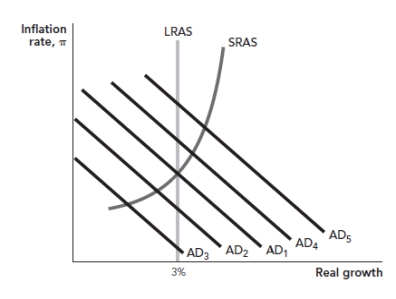Use the following to answer questions 50-54:
Figure: Monetary Policy and Demand Shocks 
-(Figure: Monetary Policy and Demand Shocks) Refer to the figure.In the figure,assume the initial real growth rate of the economy is 3% when a negative aggregate demand shock shifts the AD curve from AD1 to AD2.As a result of the Fed's policy response,the AD curve shifts to AD5 in the short run.Which of the following is TRUE about the Fed's policy response?
Definitions:
Distinguish
To recognize or treat someone or something as different from others based on specific characteristics or features.
Broadly Held Corporation
A corporation with a large number of shareholders, distributing ownership across a wide array of investors.
Closely Held Corporation
A type of corporation that has a limited number of shareholders and does not offer its shares for sale to the general public, often family-owned or controlled by a small group of investors.
Determination
The process of making a firm decision or settling a matter with conclusiveness.
Q44: The Congressional Budget Office (CBO)estimates that if
Q51: A reduction in the rate of inflation
Q72: What happens to GDP if the Fed
Q74: Suppose a high-income individual,subject to a 15%
Q126: Once some economic activity is moving in
Q147: Uncertainty drives people away from:<br>A) liquid assets
Q162: Well over half of all tax revenue
Q173: What are the four major limits to
Q223: The Federal Reserve:<br>A) clears all checks.<br>B) regulates
Q227: The economy's AD curve is:<br>A) upward sloping.<br>B)